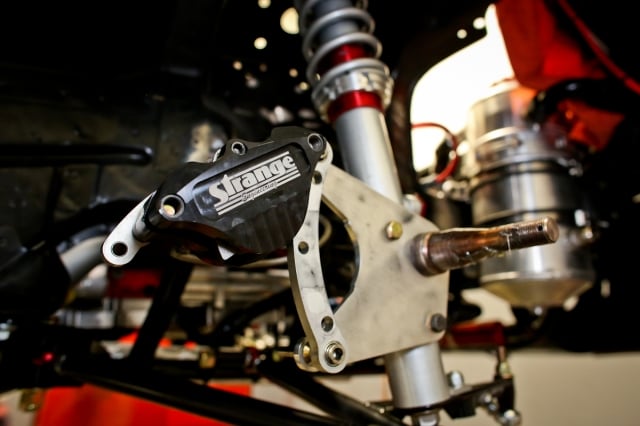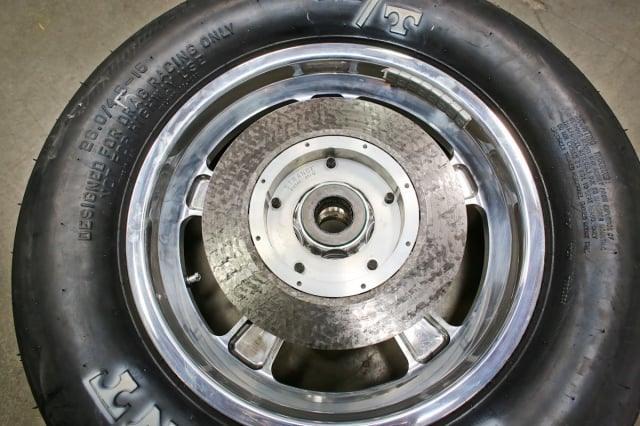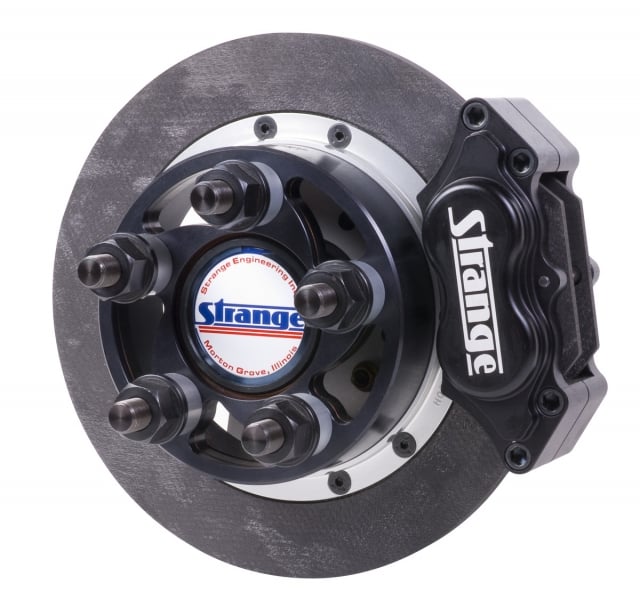Just mention the use of carbon fiber in the context of motorsports and the most common association most individuals will make is with its lightweight properties, along with it’s inherent high cost. For years, race teams in all forms of auto racing have utilized carbon fiber rather generously to create lightweight components, resulting in significantly lighter racing vehicles. Of course, that’s not to sidestep the fact that carbon fiber is also a very strong and durable material that can handle the rigors of racing as well as many forms of metals, but in the vast majority of uses, weight is the principle factor. It’s in the minority of those uses, however, that we discover a place where carbon fiber is heralded not for its low mass or high tensile strength, but for a couple of its other other distinct properties — excellent heat tolerance and low thermal expansion — that have made it a prime choice for use in racing brakes.

Carbon fiber brakes are not only the unanimous choice for the sport’s top level race cars, but in many cases, they’re a virtual requirement of the sanctioning body, due to their unparalleled performance in extreme environment. From Top Fuel and Funny Car to Pro Mods and Outlaw Radial cars, you’ll find carbon-carbon brakes behind the wheels.
Today, we’re going in-depth to discuss the use of carbon fiber in brake systems and more specifically, in drag racing applications. We’ll discuss these aforementioned material properties and how they allow for a superior stopping force, and we’ll do it all with the help of our good friends at Strange Engineering, who produce some of the most popular carbon fiber brake systems on the market to help bring 330 mph rockets, 200 mph radial tire doorslammers, and a whole lot more to almost effortless halts.
Carbon-Carbon Origins
Not surprisingly, it was the aviation industry that ushered in the use of carbon-on-carbon brake systems, particularly for military and long-haul commercial aircraft. The weight savings was key, as the reduced rolling weight allowed for improved fuel consumption and, in turn, better engine emissions. But their high energy absorption accompanied with their unbeatable service life justified their high cost to the industry. It was for these reasons and more why the technology later permeated into racing, and it would stand to reason that if carbon fiber brakes could perform to bring more than 400 tons of speeding weight to a halt on a runway, they could do the same for drag racing vehicles.
Although many of drag racing’s fastest and heaviest racing machines rely on a much simpler and more compact form of the same technology used on large aircraft, the principle, and the key advantages, all come to light in the same regard.

Carbon fiber brakes, originally developed for use in large aircraft, use carbon fiber brake rotors mated with carbon brake pads to create a stopping force with incredible high-heat stability and thermal conductivity.
According to Strange’s engineering team and engineer Jeff Capek, carbon-carbon parts consist of a carbon fiber reinforced with a carbon matrix. This results in a part that’s very stable at higher temperatures, allowing it to perform exceptionally well as a brake material, particularly under extreme temperatures where other materials may fade, warp, or experience accelerated wear.
Advantages Of Carbon
As we briefly spoke upon in the last section, there are several key factors that make carbon-on-carbon brake systems desirable in drag racing applications — and in some cases, a mandatory requirement of the sanctioning body in order to compete.
At 200, 250, 300 miles per hour, or even faster, and with half a mile or less to come to a stop, braking performance is absolutely paramount. As the sand trap and safety net at the end of the track become larger, it’s no time for brake fade or all-out failure of the braking system. This is where the operational differences of steel and carbon fiber brakes begin to exhibit themselves.

In direct opposition to how steel brakes perform, carbon fiber steps up its game as the mercury rises, reaching an optimal level of performance at 1,000 degrees Fahrenheit. Even at this temperature and at its upper operating temperature of over 5,000 degrees, carbon rotors do not warp or break.
Heat Management
Carbon fiber brakes, which utilize both a carbon rotor and brake pad, have far superior high-temperature stability, thermal conductivity, and specific heat to steel. To put it simply, where heat is the enemy of steel brakes, carbon fiber steps up to the plate and performs better as the pads and rotors heat up. And as you can imagine in drag racing applications, brakes heat up quick, particularly if the parachutes fail and the driver must rely entirely on the binders to come to a safe stop.
Carbon-carbon brakes, polar opposite to other common materials like steel and iron, work best under hot conditions. And not just “kind of” hot, but rather, it’s in the neighborhood of 1,000 degrees Fahrenheit where they really begin to work their magic. And despite that level of heat, carbon rotors will not warp, although like all composite materials, the rotors and pads can chip if handled improperly, and can also begin to oxidize above 700 degrees. For this reason, oxidization protection systems are commonly utilized.
Amazingly, even with these kinds of operating temperatures, carbon-carbon has no melting point. In fact, it has the highest sublimation point (the transition of a substance from the solid to gas phase) of all the elements at a staggering 6,588 degrees Fahrenheit. As such, the hotter the carbon fiber gets, the stronger it gets, unlike steel, which gets weaker.

Carbon fiber is one-quarter the density of steel, making it not only lighter than steel, but allowing it to both heat up and cool quicker than comparable steel brakes.
The specific heat of carbon-carbon (the amount of heat per unit mass required to raise the temperature by one degree Celsius), which we mentioned earlier in this section, is twice that of steel, making it a better “heat sponge”, as Capek explains it, for brake assemblies. Carbon also heats up quicker and cools quicker than steel because it’s one-quarter the density of steel (meaning lighter in weight) and is a better heat conductor. So despite it’s high-heat properties, carbon-carbon cools much quicker.
As one final interesting fact to note regarding the high-heat properties of carbon fiber: we’ve all seen road racing and drag racing vehicles with the brakes glowing under hard or prolonged application, and you’ve probably wondered at what temperature this phenomenon occurs. According to the information supplied to us, at 896 degrees Fahrenheit, the rotors will begin to exhibit a faint red glow. They will then turn dark red and then a bright red before turning bright orange at 1,710 degrees and a pale yellowish orange at 2,010 degrees. Above 2,550 degrees, the brakes will appear white.
Wear Properties

Wear in carbon brake rotors and pads is directly correlated to total number of brake applications. As Strange’s carbon fiber manufacturer explained to us, one hard brake application will cause less wear than several smaller applications. This gives carbon brakes a relatively impressive service life, given the types of environs in which they’re used, such as stopping 300+ mph race cars.
Drag racing teams will semi-regularly replace the carbon rotors and pads in their brake systems, but their service life is rather impressive, even following repeated hard-braking episodes. And there’s a reason for this.
Steel brake wear is proportional to the kinetic energy that the brakes absorb. The vehicle weight and the degree of braking applications directly reduce the life of steel brakes. Small, light applications with ample time to cool between applications will increase their useful life. Carbon fiber brake wear, on the other hand, correlates to the total number of brake applications. One hard application will cause less wear than several smaller applications, and carbon is less privy to weight and speed than steel. It is, in fact, cold stops, rather than heat, that directly leads to more wear in carbon-carbon brakes, as well.
Density Of Carbon Fiber
Carbon fiber material has one-quarter the density of steel, thus resulting in a much lighter part. In the case of Strange Engineering’s brake systems, the total weight of their Pro Race Carbon rear brake kits is just 15 pounds, with the 11-inch rotor tipping the scales at just 3.10 pounds. Their front kit weighs 12 pounds, while a steel kit of the same size comes in at 19 pounds. Rotating weight is paramount in the performance equation of a heads-up vehicle, and this reduced weight certainly adds up, especially on full-bodied cars carrying both front and rear brake systems.
Weight
Finally, there’s little denying that weight does indeed play a factor. As we’ve already alluded to, carbon fiber is one-quarter the density of steel, thus saving a considerable amount of weight in the rotor and pad portion of a brake assembly. That’s certainly a key selling point of carbon fiber brakes. But unlike other components, it’s not the only selling point.
Proper Carbon Brake Application
If you’ve never driven a vehicle with carbon fiber brakes before (and most of us haven’t), you’re probably wondering how best to go about utilizing them. After all, knowing what you now know about carbon brakes and their heat properties, you can probably surmise that there’s a difference in how they react compared to steel, and you’d be correct. As Capek explains to us, a strong application, in the event of something like a parachute failure, is preferred so as much torque as possible is realized for optimum stopping power. With carbon brakes, one firm application results in less wear than several smaller applications, and maximum carbon brake life can be achieved by using a number of long, moderately firm applications rather than several lighter applications.
Strange’s Pro Race Carbon Brakes
Strange Engineering’s line of carbon fiber brake systems are one of the most popular setups in the sport, with racers in Top Fuel, Funny Car, the Top Alcohol categories, Pro Stock, Pro Modified, outlaw small-tire doorslammers, and many others relying on the them to bring their cars to a safe stop. And there’s a good reason for that, as Strange has poured several years of R&D and ample financial resources into developing a top-notch product over the last couple of decades, since first introducing their carbon brake systems in the 1980’s.

Strange’s carbon brake systems are some of the most popular kits in use today by the sport’s top race teams. These kits come in 10-inch (front), and 11-inch rear (Pro Race and Sportsman), and a 11.5-inch rear for nitro cars.
“We’ve done tons of research and development with our carbon brake systems that’s led to great benefits for the racers,” says Strange’s JC Cascio. “We’ve worked with several carbon suppliers and race teams to find the right combination of material, including some extensive testing in the past with Warren and Kurt Johnson.
“There are many variations of carbon combinations that can act differently when utilized together, and so it’s really been about dialing in the right combination of carbon for the market that we’re using it in. The time and dedication we’ve put into these brakes, we feel, sets them apart.”
There are many variations of carbon combinations that can act differently when utilized together, and so it’s really been about dialing in the right combination of carbon for the market that we’re using it in. – JC Cascio
Strange offers four distinct Pro Race Carbon products that are suited to a range of the sport’s faster and heavier race cars. The lineup begins with their 10-inch front brake kit, which is used on the majority of nitro Funny Cars on down to radial tire doorslammers and the like. Although Cascio tells us that some Funny Car teams have moved to an 11-inch rotor setup on the front, the 10-inch kit has proven to be a solid performer regardless of the vehicle.
Moving to the rear of the car, Strange offers an 11-inch Pro Race rear, an 11-inch carbon Sportsman kit, and finally, an 11.5-inch live axle setup for Top Loader rear ends used on Top Fuelers and Funny Cars. The latter kit, according to Cascio, features a slightly thicker rotor to help cope with the 300-plus mile per hour speeds, but is otherwise the same as the other kits.

Strange’s carbon brake kits (like this one shown with one of their struts) offers a 40% reduction in weight over comparable steel and cast iron brakes. The internals of the calipers are very similar, with a pair of methods for shielding the brake fluid from the intense heat being the primary difference.
These carbon systems are similar in their makeup to their steel counterparts in terms of the calipers, aside from the obvious difference that these use carbon pads and rotors. One difference you will find is the use of a small titanium heat shield between the pads and the pistons or an upgraded two-piece, ceramic-coasted piston to isolate the brake fluid and prevent it from boiling in the extreme high-heat environs of carbon brakes.
Strange’s carbon brake kits also offer a significant weight savings over comparable steel brakes. Strange boasts a 40-percent reduction in weight, and those numbers certainly add up when you multiply them by all four corners on the race car. The 10-inch front kits weight in at 12 pounds while the 11-inch Pro Race rear tips the scale at 15 pounds — marking the lightest 11-inch brake kit on the market.
In terms of service life, Cascio shares with us that most racers can and do utilize a single carbon rotor throughout a full season, but will typically replace the pads twice a year. For doorslammer racers who may only compete a handful of times a season, this makes for a pretty solid and long-term investment.
Of course, that investment is multi-fold, when you look beyond the lighter weight and the impressive service life. Carbon brake systems like Strange’s Pro Race and Carbon Sportsman provide the safest product one can buy, with unrivaled stopping performance and reliability thanks to the eliminations of fade, failure, and destruction. Call it a cliche, but it’s hard to put a price on your own safety. The rest is just icing on the cake.



















